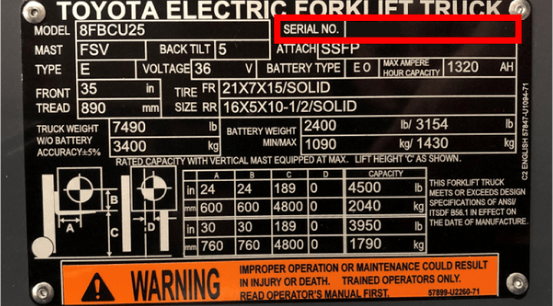How to Find Your Equipment Model Number.
Finding the right parts for your equipment is easy when you have your model and serial number which can be found on the data plate. Luckily, a forklift data plate is installed on every truck on the market to help you understand what your forklift can do and provide vital information.
Model Number: The model number of your toyota forklift is extremely important for relaying information to your dealers about repair or technical assistance and for looking up replacements part!
Serial Number: The serial number on your lift is the most important number.The model serial number combination will allow us to provide you with the parts that will fit your particular piece of equipment.

How to Find Your Equipment Serial Number
Finding the right parts for your equipment is easy when you have your model and serial number which can be found on the data plate. Luckily, a forklift data plate is installed on every truck on the market to help you understand what your forklift can do and provide vital information.
Model Number: The model number of your toyota forklift is extremely important for relaying information to your dealers about repair or technical assistance and for looking up replacements part!
Serial Number: The serial number on your lift is the most important number.The model serial number combination will allow us to provide you with the parts that will fit your particular piece of equipment.

Need some help? For further assistance or more information, contact your local Toyota Dealer.

Please click below to sign in to your MyToyota account
Don't have an account?
Which Forklift Energy Source is Best for Your Operational Environment?

Selecting the appropriate forklift energy source to drive success is a choice that depends significantly on the needs of your specific operation. And while there are a wide variety of factors that may influence your decision between electric and internal combustion options, the facility you are operating in will have a clear impact on the performance of each option.
Whether you work in cold storage or the great outdoors, the temperature and other environmental factors of the areas where your forklifts operate make a big difference in the type of battery or fueling option you’ll want to use.
Consider each of these “environmental factors” when weighing your energy options.
Indoor vs. Outdoor
Traditional wisdom dictates that outdoor operations use internal combustion forklifts. But with new pneumatic electric options on the market, batteries can be considered for outdoor applications.
Operating Temperatures
Cold-storage options often run electric forklifts with built-in component insulation. But don’t neglect to consider the ambient temperature change when moving room to room. One consideration is lithium-ion batteries run longer and operate at a higher voltage than lead-acid batteries in cold temperatures, leading to performance advantages.
Lithium-ion batteries can also be manufactured with a heater, allowing the battery to stay warm while operating in a cold environment while also functioning at full-capacity in ambient temperatures.
UL-Certification
Underwriter’s Laboratory (UL) provides guidelines for the use of equipment in certain industries and applications. Your application may require a certain specific UL certification. Toyota was the first to market with a UL-E and UL-EE-approved sit-down forklift and lithium-ion battery combination — a great option for those in need of equipment meeting these standards.
Facility Space
Forklift batteries require space for storage, charging, and maintenance. Your existing facility layout and available space can influence your energy choice.
Governmental Regulations
One of the most influential governing bodies on forklift emission regulation across the U.S., the California Air Resources Board’s (CARB) regulations, have an impact on fuel choice – especially when selecting diesel, propane, or compressed natural gas options. Regions that do not follow CARB still need to abide by Environmental Protection Agency (EPA) and local emissions regulations, as well as the Occupational Health and Safety Administration (OSHA) or Canadian Centre for Occupational Health and Safety (CCOHS).
To learn more about your forklift energy options, visit Energy Solutions or contact your local, authorized Toyota Dealer today.